SEVICK'S BOOK
Understanding, Building, and Using Baluns and Ununs
Although this is an outstanding book with clear explanations of how to build all sorts of baluns, it also has a few mistakes and has failed to address a few important points.
As a result, this has had a catastrophic affect on the antenna and balun industries in our hobby. I will elaborate on the ill affects these mistakes have had at the end of this page.
First, I will post a dialog between Tom Rauch, W8JI and Steve Hunt, G3TXQ (SK) in a group discussion on "Baluns, antenna's, and W8JI DX Engineering articles". I will also show a link to this original discussion.
For those of you not familiar with Tom or Steve:
- Tom designed most of the baluns sold by DX-Engineering, and has one of the best ham radio pages on the web: https://w8ji.com/
- Steve was the developer of the Wide-Band HEX BEAM and an authority on Baluns. The G3TXQ COLOR CHARTS showing Common Mode Impedance of different Ferrite-Mix Toroids are well known. He too has one of the best web pages for ham radio: http://www.karinya.net/g3txq/
IMPORTANT: I am not trying to discredit this book; it is indeed an excellent book. I am only cautioning readers to be aware of additional information so that they do not read and interpret more out of this than is meant.

The following discussion took place in late July / early August 2011 in an eHam discussion entitled Baluns, antenna's, and W8JI DX Engineerings Articles
I have extracted the important bits from the original discussion to keep it short and crisp. Feel free to read the original transcription. Continue below:
It began with AC5UP making the following statement:
The holy grail of balun design is: http://www.amazon.com/Understanding-Building-Using-Baluns-Ununs/dp/094301624X (links to Sevick's book)
An interesting and informative discussion followed, including several comments by Steve Hunt, G3TXQ (SK), and Tom Rauch, W8JI.
I will show these original comments below as screen-shots taken from the original conversation, and then give my own "subjective" analysis/opinion of the consequences of all of this at the end of the discussion.
It began when G3TXQ pointed out that there are serious misunderstandings in the book:
(Note: Comments between the photos from the discussion are mine (DJ0IP).

Following a few remarks from others, W8JI posted the following where he pointed out that one of the baluns described in the book is not even a balun.
[Note: Tom was referring to the single-core 4:1 balun shown in Photo 8-E at the bottom of page 30 of Sevick's book.]
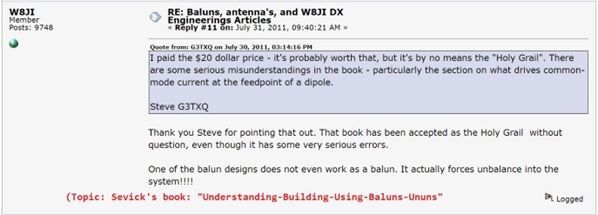

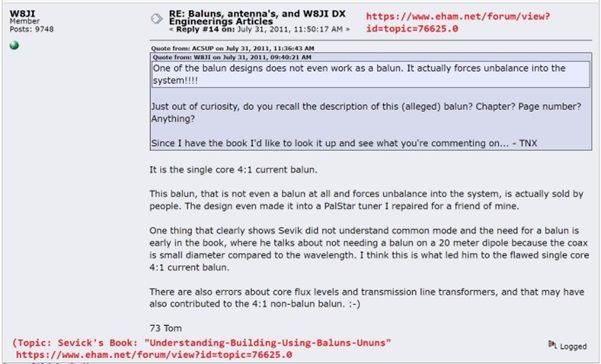

In his post above notice that Steve referred to the single-core 4:1 Guanella "device" that Sevick calls a "Current Balun" as a "Voltage-UnBalun"! I just call it a "transformer".
... and then Steve continued in his next post, pointing out some serious flaws:

[Note: no “hate mail” followed.] Then G3TXQ continued:

[Note: Steve gave me permission to show this on my web site.
See: Mathematical Proof and Lab Measurements .]
(These links open in separate windows.)
And now here's the part that disappoints me (DJ0IP) about Sevick:
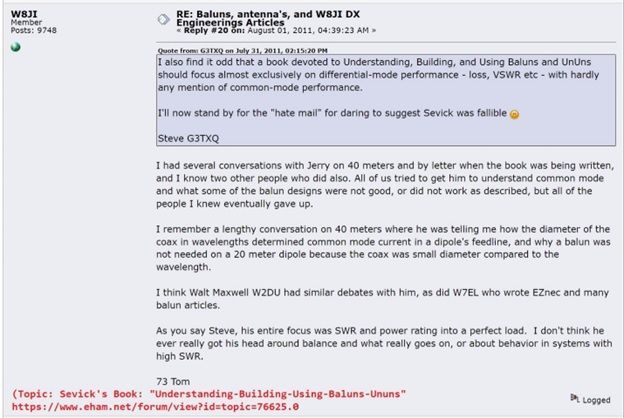
As you see in Tom's comments above, several very technical OM tried to reason with Sevick but he would not listen. If he had only listened, we would probably have thousands more happy campers today than we do now.
Several balun manufacturers went on to build and sell baluns that Sevick described that simply did not work. They are not baluns; just transformers. Unfortunately, some balun manufacturers still build and sell these "Voltage-UnBaluns" today (i.e., the one in Texas).
These baluns were then used in antennas such as the Off-Center-Fed Dipole (OCFD) where their failure to impede Common Mode Current caused their users many problems.
[ End of this 2011 Discussion ]
FURTHER DISCUSSION:
Here is my (DJ0IP) summary of the issues pointed out by G3TXQ and W8JI:
- Not understanding what drives common mode current at the feedpoint of a dipole.
- The single-core 4:1 Guanella “balun” is not even a balun. It actually forces an unbalance into the system.
- If you follow the link G3TXQ posted to his web site, you will see he determined that this “unbalun” not only has zero common mode impedance, it actually generates common mode current.
- Sevick did not understand common mode. This is what led him to believe a single-core 4:1 Guanella can work.
- There are errors about core flux levels and transmission line transformers.
- An almost exclusive focus on differential current, SWR and power rating into a perfect load, with hardly any mention of common mode current.
- Sevick ignored several gurus trying to correct him before his book was published.
Here are some further issues I personally have with Sevick's book, in addition to those pointed out by Steve and Tom above:
- Sevick shows how to build all sorts of baluns, however, he fails to mention that his examples are just one way of building them. Although he does not imply that this is the 'only' way to built them, many hams and sadly even some Balun Manufacturers seem the think so.
- As we have seen from G3TXQ's color charts comparing various ferrite mixes and number of turns of transmission line, the amount of Common Mode Impedance that a choke (or choke-balun) has across the HF spectrum depends highly on these two factors.
As seen in this first chart below showing 4 popular ferrite mixes used in baluns and chokes, the Common Mode Impedance of a choke varies significantly, depending the the ferrite mix:
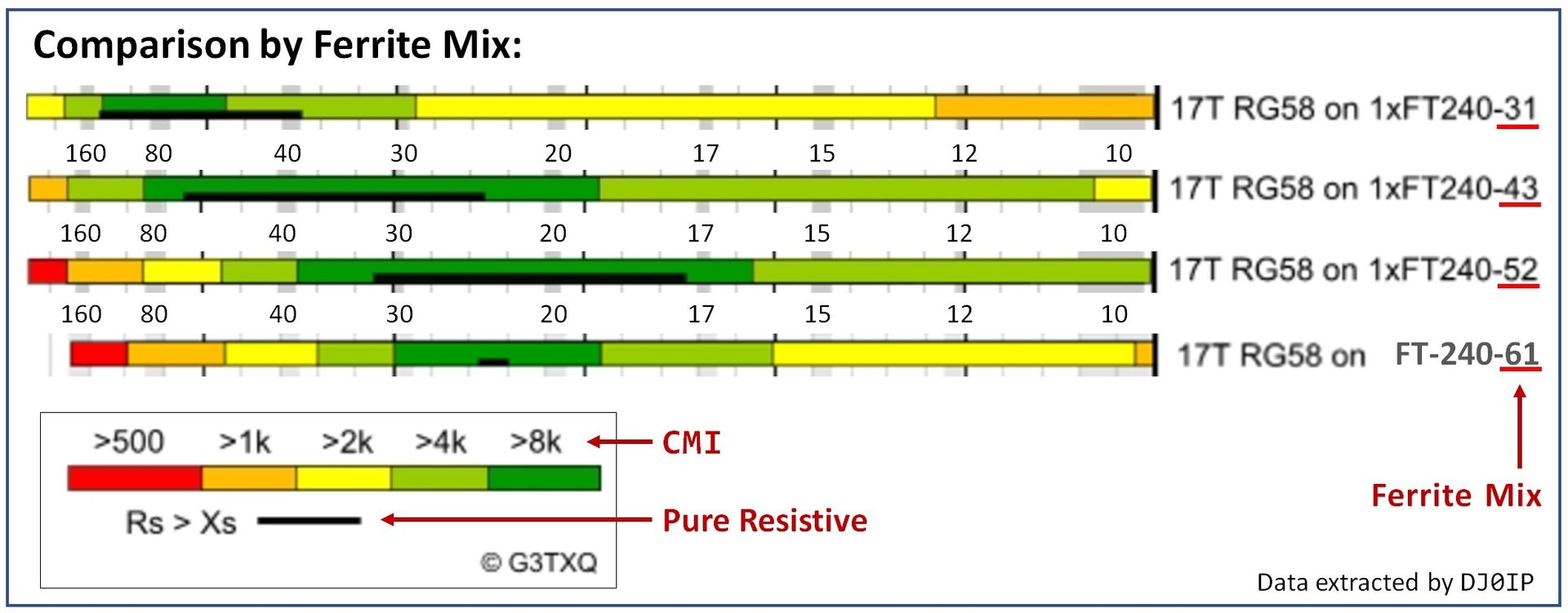
The next chart shows how much difference the number of turns of transmission line makes on the amount of Common Mode Current the choke has. It shows this for #31 ferrite and for #43 ferrite.
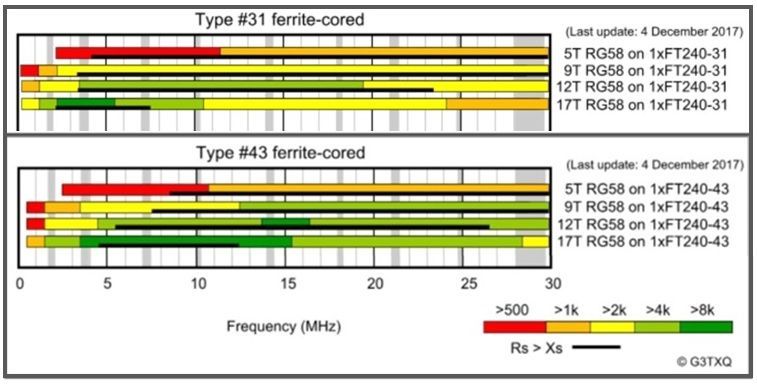
It is very disappointing that Sevick failed to point out these very important differences in his book. It misleads people into believing they must use the exact same ferrite mix and turns count that he used!
- Since Sevick neglected speaking about Common Mode Current throughout his book, there was no mention that different types of antennas have different Common Mode Current characteristics. Thus the reader probably does not even suspect that different builds of the balun/choke might be necessary.
Unless affected by external objects, balanced (center-fed) dipoles and especially loops have a very low tendency to produce Common Mode Current. OCFD and especially the EFHW antennas have a very high tendency to induce Common Mode Current onto the feedline. As such, OCFD and EFHW antennas need significantly more Common Mode Impedance in their baluns/chokes than dipoles or loops.
- Sevick used bifilar [bare] enamel-insulated copper wire in most of his baluns.
- Although bifilar transmission lines are OK to use, he fails to mention that we can also use twisted pair transmission lines in many of the baluns instead of bifilar. Indeed, W8JI, VK1OD, and of course DJ0IP (me) often use twisted pair. Unless I missed it, Sevick did not suggest using twisted pair.
Here's what W8JI says about twisted pair, comparing it to bifilar:
For differential mode currents between turns, the wire-to-wire coupling is tighter and impedance lower with twisted turns. This affects SWR bandwidth a great deal.
- Bare enamel-insulated wire wound directly onto a toroid "can be" a major cause of break-down in baluns and chokes. This is no issue at QRP power levels, but can become an issue at higher power levels when the Toroid heats up. This happens often when the antenna is generating a lot of Common Mode Current. Indeed, most balun manufacturers now use Teflon-insulated wire in their high-power baluns and chokes.
CONCLUSION:
Although this book is still one of the best sources of information on how to build the various types of baluns, ununs, & chokes, it is definitely NOT The Holy Grail on this topic.
For additional information on this topic, I strongly recommend you consult reliable sources for learning. These include G3TXQ, K9YC, VK1OD, W7EL and W8JI.
Hopefully the information on this page will help readers to better understand how to use this book as a "guide" to building these devices.
